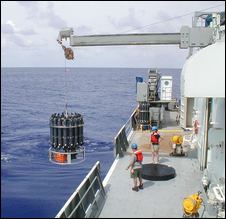forum
library
tutorial
contact

Research in Pacific Shows Ocean Trouble
by Lisa StifflerSeattle Post-Intelligencer, March 31, 2006
|
the film forum library tutorial contact |

|
Research in Pacific Shows Ocean Troubleby Lisa StifflerSeattle Post-Intelligencer, March 31, 2006 |
Acidity rises, oxygen drops, scientists find
Research fresh off a boat that docked Thursday in Alaska reveals some frightening changes taking place in the Pacific Ocean.
As humans are pumping out more carbon dioxide that is helping to warm the planet, the ocean has been doing yeoman's work to lessen the effects -- but it's taking a toll.
 Over time, the changes could have an impact that ripples through the food chain, from microscopic plants that can't grow right to salmon and whales unable to find enough to eat.
Over time, the changes could have an impact that ripples through the food chain, from microscopic plants that can't grow right to salmon and whales unable to find enough to eat.
The Pacific is getting warmer and more acidic, while the amount of oxygen and the building blocks for coral and some kinds of plankton are decreasing, according to initial results from scientists with National Oceanic and Atmospheric Administration's Pacific Marine Environmental Laboratory, the University of Washington and elsewhere.
"There are big changes," said Christopher Sabine, chief scientist for one leg of the research trip, which ultimately traveled from Antarctica to Alaska.
Many of the most interesting results are tied to the ocean becoming increasingly acidic because of its absorption of carbon dioxide.
"You don't have to believe in climate change to believe that this is happening," said Joanie Kleypas, an oceanographer with the University Corporation for Atmospheric Research, a non-profit organization based in Boulder, Colo. "It's pretty much simple thermodynamics."
And it's alarming.
"Acidification is more frightening than a lot of the climate change issues," Kleypas said. That's in part because the process is hard to alter.

"It's a slow-moving ship, and we're all trying to row with toothpicks," she said. Carbon dioxide is a byproduct of burning fossil fuels such as oil and gas. Over the past 200 years, the ocean has absorbed about half of what's been released into the atmosphere.
Sabine and the other researchers found that in the past 15 years, there's been a detectable decline in the ocean's pH, which is a measure of acidity ranging from zero to 14, with zero being most acidic (water is neutral, or pH 7, while seawater is about pH 8).
The pH of the saltwater has dropped 0.025 units since the early 1990s. The number seems unremarkable, but the pH scale is exponential, so a one-unit drop is a 10-fold decrease. The new measurement also puts the ocean on track for a dramatic decline by the end of the century.
Plankton -- tiny plants and animals that live in the ocean -- are among the creatures that could be harmed by the change. In addition to the water becoming more acidic, the extra carbon dioxide reduces the amount of chemical compounds used to construct coral and the shells of plankton.
"That's a major issue," said John Guinotte, a marine scientist with the Bellevue-based Marine Conservation Biology Institute who studies deep sea corals.
"You're likely looking at serious effects through out the marine food web across the board," he said.
The pole-spanning trip that ended Thursday is part of the Repeat Hydrography project. The most recent trip was aboard the Thomas G. Thompson, a UW-operated vessel, and lasted about three months. Thirty-five scientists from about a dozen universities and government labs participated.
The plan is to survey 19 routes crisscrossing all the world's oceans, then repeat those trips every 10 years to detect trends in ocean conditions. Ocean measurements were taken every 60 miles from the surface to the bottom of the sea.
Researchers from California State University-San Marcos and the University of South Florida towed nets behind the vessel to catch plankton, which they then subjected to acidic conditions on par with what might be experienced in the future.
"They're seeing that the shells of these organisms start to dissolve even while the organism is still living," said Sabine, an oceanographer with NOAA's Seattle lab.
Some of the creatures tested are little snails that are "a major food source for salmon and whales and these larger things and they make a shell that is very susceptible to a decrease in pH," he said.
Other experiments show that microscopic plants at the base of the food chain that build protective plates out of calcium carbonate don't grow properly in the acidic water.
"We don't expect to go out and find living organisms with dissolving shells," Sabine said. "We expect to find perhaps a change in where these organisms are thriving or perhaps fewer of them over time."
The ocean scientists expressed an urgency over reducing carbon dioxide emissions as soon as possible.
"Anything we can do to slow that rate of change will slow the rate of response in the oceans as well," said Kleypas. "It buys us some time."
Related Sites:
The national project: ushydro.ucsd.edu
Local participants:
www.pmel.noaa.gov/co2/co2-home.html
learn more on topics covered in the film
see the video
read the script
learn the songs
discussion forum
